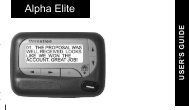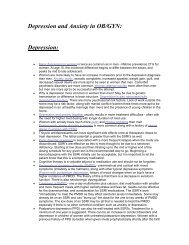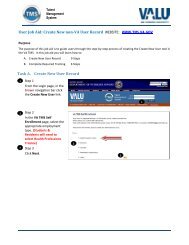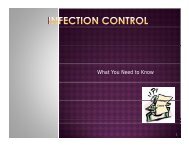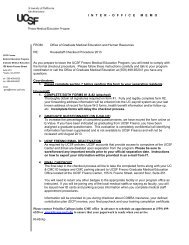UC W4NR Instructions - UCSF Fresno
UC W4NR Instructions - UCSF Fresno
UC W4NR Instructions - UCSF Fresno
You also want an ePaper? Increase the reach of your titles
YUMPU automatically turns print PDFs into web optimized ePapers that Google loves.
Part I: General <strong>Instructions</strong><br />
<strong>Instructions</strong> for completing the Federal<br />
Portion of the Form<br />
<strong>UC</strong> W-4NR/DE 4 2013<br />
Nonresident Alien Employee's Federal-State Withholding Allowance Certificate<br />
Complete Form <strong>UC</strong> W-4NR/DE 4 so your<br />
employer can withhold the correct Federal<br />
income tax from your pay.<br />
The Internal Revenue Code restricts a<br />
nonresident alien's filing status, limits the<br />
number of allowable exemptions, and<br />
requires additional tax to be withheld from<br />
wage payments because a nonresident<br />
alien cannot claim the standard deduction.<br />
Refer to IRS Publication 515, Withholding<br />
of Tax on Nonresident Aliens and Foreign<br />
Corporations and IRS Notice 1036 for more<br />
information.<br />
Whenever your personal income tax<br />
withholding status changes, you should<br />
submit a new form to your employer.<br />
Who May Use This Form<br />
This form is intended for use by nonresident<br />
alien individuals who are employed in the<br />
U.S.<br />
Any individual who is not a citizen or<br />
resident of the United States is a<br />
nonresident alien. An alien individual<br />
meeting either the “green card test” or the<br />
“substantial presence test” for the calendar<br />
year is a resident alien for tax purposes.<br />
Any person not meeting either test is a<br />
nonresident alien for tax purposes.<br />
To ensure that the proper amount of<br />
Federal tax is withheld, it is essential to<br />
establish your residency status with your<br />
employer prior to completion of this form.<br />
A resident alien should complete the Form<br />
<strong>UC</strong> W-4/DE 4.<br />
For more information on resident and<br />
nonresident alien status, the tests for<br />
residence (including the substantial<br />
presence test), see Publication 519, U.S.<br />
Tax Guide for Aliens.<br />
Specific <strong>Instructions</strong> for Form <strong>UC</strong><br />
W-4NR/DE 4<br />
The following instructions are for those<br />
items that are not self-explanatory:<br />
Part 1 - Federal Tax Filing Status and<br />
Allowances<br />
1. Nonresident aliens may only claim<br />
“Single” marital status on line 1<br />
(regardless of your actual marital<br />
status).<br />
2. Claim “0” (zero) or “1” withholding<br />
allowance on line 2.<br />
Please note that Nonresident Aliens cannot<br />
claim “Exempt” withholding status on this<br />
form. (See Tax Treaties.)<br />
Residents of Canada, Mexico, or a<br />
U.S. national:<br />
If you are a resident of Canada, Mexico, or a<br />
U.S. national (i.e., a citizen of America<br />
Samoa or a Northern Mariana Islander who<br />
chose to become a U.S. national) you may<br />
claim an allowance for your spouse if the<br />
following conditions are met:<br />
A joint tax return is not filed,<br />
Your spouse had no gross income for U.S.<br />
tax purposes, and<br />
Your spouse cannot be claimed as a<br />
dependent by another taxpayer<br />
In addition, you can claim an allowance for<br />
your dependents that meet the<br />
dependency tests. See Publication 501<br />
for dependency rules.<br />
Enter the total number of allowances you are<br />
claiming on line 2.<br />
Residents of South Korea<br />
If you are a resident of South Korea you may<br />
be able to claim an allowance for your<br />
spouse and dependents if the following<br />
additional conditions are met:<br />
Your spouse and all children claimed must<br />
live with you in the U.S. at some time<br />
during the tax year, and<br />
The additional deduction for allowances<br />
must be prorated based on the ratio of<br />
your U.S. source gross income effectively<br />
connected with a U.S. trade or business.<br />
See Publication 519 for the rules<br />
regarding the proration.<br />
Enter the total number of allowances you are<br />
claiming on line 2.<br />
Students and Business Apprentices<br />
from India<br />
If you are a student or a business<br />
apprentice who is eligible for the benefits of<br />
Article 21(2) of the United States-India<br />
Income Tax Treaty, you can claim additional<br />
withholding allowances on line 2 for your<br />
spouse and dependents if the following<br />
conditions are met:<br />
Your spouse had no gross income for<br />
U.S. tax purposes, and<br />
A joint tax return is not filed, and<br />
Your spouse cannot be claimed as a<br />
dependent by another taxpayer.<br />
You may also claim additional<br />
exemptions for children who reside with<br />
you with certain restrictions including<br />
meeting all residency tests. See IRS<br />
Publication 515 for more details.<br />
You may not claim exemptions for<br />
dependents who are admitted to the U.S.<br />
on an “F-2”, “J-2”, or “M-2” visas unless<br />
such dependents have become resident<br />
aliens.<br />
Enter the total number of allowances you<br />
are claiming on line 2.<br />
See IRS Pub 519 for more information on<br />
claiming exemptions.<br />
Tax Treaties<br />
The U.S. has income tax treaties with a<br />
number of foreign countries under which<br />
teachers, researchers professors, trainees<br />
and scholarship recipients of those<br />
countries are exempt from Federal tax on<br />
income received from teaching and<br />
research activities. If you are eligible to<br />
claim tax treaty benefits you must give your<br />
Withholding agent a Form 8233 and a tax<br />
treaty statement or Form <strong>UC</strong> W-8BEN to<br />
obtain these benefits.<br />
For more information on U.S. tax treaties<br />
see Publication 901, U.S. Tax Treaties.<br />
Services Performed Outside the<br />
United States<br />
Compensation paid to a nonresident alien<br />
for services performed entirely outside the<br />
U.S. is considered to be foreign source<br />
income; therefore no U.S. tax withholding is<br />
required. However, if you perform services<br />
within and without the U.S., the total amount<br />
of compensation must be prorated based on<br />
the total amount paid and total time related<br />
with the performance of services.
<strong>Instructions</strong> and worksheets for completing<br />
The STATE portion of the Form<br />
<strong>UC</strong> W-4NR/DE 4 2013<br />
Nonresident Alien Employee's Federal-State Withholding Allowance Certificate<br />
* Use this section for instructions and worksheets to complete<br />
the STATE (DE 4) portion of the form <strong>UC</strong> W-4NR/DE 4<br />
YOUR CALIFORNIA PERSONAL INCOME TAX MAY BE UNDERWITHHELD<br />
IF YOU DO NOT FILE THIS DE 4 FORM<br />
IF YOU RELY ON THE FEDERAL W-4 FOR YOUR CALIFORNIA WITHHOLDING ALLOWANCES, YOUR<br />
CALIFORNIA STATE PERSONAL INCOME TAX MAY BE UNDERWITHHELD AND YOU MAY OWE<br />
MONEY AT THE END OF THE YEAR.<br />
PURPOSE: This certificate, DE 4, is for California<br />
personal income tax withholding purposes only.<br />
You should read the instructions contained herein and<br />
complete the State portions of the <strong>UC</strong> W-4NR/DE 4<br />
form as appropriate, using the worksheets that follow<br />
as applicable.<br />
You should complete this form if either:<br />
1. You claim a different marital status, different<br />
number of regular allowances, or a different<br />
additional dollar amount to be withheld for<br />
California personal income tax withholding than you<br />
claim for federal income tax withholding or,<br />
2. You claim additional allowances for estimated<br />
deductions.<br />
THIS FORM WILL NOT CHANGE YOUR FEDERAL<br />
WITHHOLDING ALLOWANCES.<br />
The Federal tax brackets and withholding methods do not<br />
reflect state personal income tax withholding tables. If<br />
you rely on the number of withholding allowances you<br />
claim for Federal withholding your state income tax<br />
withholding, may be significantly underwithheld. This<br />
is particularly true if your household income is derived<br />
from more than one source.<br />
CHECK YOUR WITHHOLDING:<br />
After your <strong>UC</strong> W-4NR/DE 4 takes effect, compare the<br />
dollar amounts that are being withheld to ensure that the<br />
proper amount of tax is being withheld.<br />
EXEMPTION FROM WITHHOLDING:<br />
You may only claim exempt from withholding California<br />
income tax if you did not owe any federal income tax last<br />
year and you do not expect to owe any federal income tax<br />
this year. Also, under the Service Member Civil Relief Act,<br />
as amended by the Military Spouses Residency Relief Act,<br />
you may be exempt from California income tax on your<br />
wages if 1) your spouse is a member of the armed forces<br />
present in California in compliance with military orders; 2)<br />
you are present in California solely to be with your spouse;<br />
and 3) you maintain your domicile in another state. If you<br />
claim this exemption, you may be required to submit proof.<br />
The exemption for California income tax withholding<br />
automatically expires on February 15 of the next year<br />
unless submitted again on a new W-4NR/DE 4 before that<br />
date.<br />
The law requires you to give your employer a new<br />
Form <strong>UC</strong> W-4NR/DE 4 by December 1.
NOTIFICATION: Your employer is required to send a copy of your DE 4 to the Franchise Tax Board if it meets any of the following conditions:<br />
You claim more than 10 withholding allowances<br />
You claim exemption from State or Federal income tax<br />
withholding and your employer expects your usual weekly wages<br />
to exceed $200 per week.<br />
IF THE IRS INSTR<strong>UC</strong>TS YOUR EMPLOYER TO WITHHOLD FEDERAL INCOME TAX BASED ON A CERTAIN WITHHOLDING STATUS, YOUR<br />
EMPLOYER IS REQUIRED TO USE THE SAME WITHHOLDING STATUS FOR STATE INCOME TAX WITHHOLDING IF YOUR WITHHOLDING<br />
ALLOWANCES FOR STATE PURPOSES MEET THE REQUIREMENTS LISTED UNDER “NOTIFICATION.” IF YOU FEEL THAT THE FEDERAL<br />
DETERMINATION IS NOT CORRECT FOR STATE WITHHOLDING PURPOSES, YOU MAY REQUEST A REVIEW.<br />
To do so, write to: Franchise Tax Board<br />
W-4 Unit MS F 180, P. O. Box 2952<br />
Sacramento CA 95812-2952<br />
Fax: (916) 843-1094<br />
Your letter should contain the basis of your request for review. You will have the burden of showing the federal determination incorrect for state withholding<br />
purposes. The Franchise Tax Board (FTB) will limit its review to that issue. FTB will notify both you and your employer of its findings. Your employer is then<br />
required to withhold state income tax as instructed by FTB. In the event FTB or IRS finds there is no reasonable basis for the number of withholding<br />
exemptions that you claimed on your <strong>UC</strong> W-4NR/DE 4, you may be subject to a penalty.<br />
PENALTY: You may be fined $500 if you file, with no reasonable basis a DE 4 that results in less tax being withheld than is properly allowable. In addition,<br />
criminal penalties apply for willfully supplying false or fraudulent information or failing to supply information requiring an increase in withholding. This is<br />
provided for by Section 19176 of the California Revenue and Taxation Code.<br />
INSTR<strong>UC</strong>TIONS – 1 – ALLOWANCES*<br />
When determining your withholding allowances, you must consider<br />
your personal situation:<br />
— Do you claim allowances for dependents or blindness<br />
— Are you going to itemize your deductions<br />
— Do you have more than one income coming into the household<br />
TWO-EARNER/TWO-JOBS: When earnings are derived from more<br />
than one source, under withholding may occur. If you have a working<br />
spouse or more than one job, it is best to check the box “SINGLE or<br />
MARRIED (with two or more incomes).” Figure the total number of<br />
allowances you are entitled to claim on all jobs using only one DE 4<br />
form. Claim allowances with one employer. Do not claim the same<br />
allowances with more than one employer. Your withholding will<br />
usually be most accurate when all allowances are claimed on the DE 4<br />
or W-4 filed for the highest paying job and zero allowances are<br />
claimed for the others.<br />
MARRIED BUT NOT LIVING WITH YOUR SPOUSE: You may check the<br />
“Head of Household” marital status box if you meet all of the following<br />
tests:<br />
1) Your spouse will not live with you at any time during the year;<br />
2) You will furnish over half of the cost of maintaining a home for the<br />
entire year for yourself and your child or stepchild who qualifies as<br />
your dependent; and<br />
3) You will file a separate return for the year.<br />
HEAD OF HOUSEHOLD: To qualify, you must be unmarried or legally<br />
separated from your spouse and pay more than 50% of the costs of<br />
maintaining a home for the entire year for yourself and your dependent(s)<br />
or other qualifying individuals. Cost of maintaining the home includes<br />
such items as rent, property insurance, property taxes, mortgage interest,<br />
repairs, utilities, and cost of food. It does not include the individual’s personal<br />
expenses or any amount which represents value of services performed by a<br />
member of the household of the taxpayer.<br />
WORKSHEET A<br />
REGULAR WITHHOLDING ALLOWANCES<br />
(A) Allowance for yourself — enter 1<br />
(B) Allowance for your spouse (if not separately claimed by your spouse) — enter 1<br />
(C) Allowance for blindness — yourself — enter 1<br />
(D) Allowance for blindness — your spouse (if not separately claimed by your spouse) — enter 1<br />
(E) Allowance(s) for dependent(s) — do not include yourself or your spouse<br />
(A)<br />
(B)<br />
(C)<br />
(D)<br />
(E)<br />
(F) Total — add lines (A) through (E) above, Enter here and in Section ll, Box 2 of the <strong>UC</strong> W-4/DE 4 . (F)
INSTR<strong>UC</strong>TIONS — 2 — ADDITIONAL WITHHOLDING ALLOWANCES<br />
If you expect to itemize deductions on your California income tax return, you can claim additional withholding allowances. Use Worksheet B to determine<br />
whether your expected estimated deductions may entitle you to claim one or more additional withholding allowances. Use last year’s FTB 540 form as a<br />
model to calculate this year’s withholding amounts.<br />
Do not include deferred compensation, qualified pension payments or flexible benefits, etc., that are deducted from your gross pay but are not taxed on<br />
this worksheet.<br />
You may reduce the amount of tax withheld from your wages by claiming one additional withholding allowance for each $1,000, or fraction of $1,000, by<br />
which you expect your estimated deductions for the year to exceed your allowable standard deduction.<br />
WORKSHEET B<br />
ESTIMATED DED<strong>UC</strong>TIONS<br />
1. Enter an estimate of your itemized deductions for California taxes for this tax year as listed in the<br />
schedules in the FTB 540 form………………………………………………………………………………. 1.<br />
.<br />
2. Enter $7,682 if married filing joint with two or more allowances, unmarried head of household or<br />
qualifying widow(er) with dependent(s) or $3,841 if single or married filing separately, dual income married, or<br />
married with multiple employers.<br />
- 2.<br />
3. Subtract line 2 from line 1, enter difference = 3.<br />
4. Enter an estimate of your adjustments to income (alimony payments, IRA deposits) + 4.<br />
5. Add line 4 to line 3, enter sum = 5.<br />
6. Enter an estimate of your nonwage income (dividends, interest income, alimony receipts) - 6.<br />
7. If line 5 is greater than line 6 (if less, see below);<br />
Subtract line 6 from line 5, enter difference = 7.<br />
8. Divide the amount on line 7 by $1,000, round any fraction to the nearest whole number 8.<br />
Enter this number here and in Section II, Box 3, of the <strong>UC</strong> W-4/DE 4. Complete Worksheet C, if needed.<br />
9. If line 6 is greater than line 5:<br />
Enter amount from line 6 (nonwage income) 9.<br />
10. Enter amount from line 5 (deductions) 10.<br />
11. Subtract line 10 from line 9, enter difference 11.<br />
Complete Worksheet C<br />
* Wages paid to registered domestic partners will be treated the same for state income tax purposes as wages paid to spouses for California Personal Income Tax<br />
(PIT) withholding and PIT wages. This new law does not impact federal income tax law. A registered domestic partner means an individual partner in a domestic<br />
partner relationship within the meaning of Section 297 of the Family Code. For more information, please call our Taxpayer Assistance Center at 888-745-3886.<br />
DE 4 Rev. 41 (01-13)
WORKSHEET C – for Section IV, Box 2, of the <strong>UC</strong> W-4/DE 4. TAX WITHHOLDING AND ESTIMATED TAX<br />
1. Enter estimate of total wages for tax year 2013<br />
2. Enter estimate of nonwage income (line 6 of Worksheet B)<br />
3. Add line 1 and line 2. Enter sum<br />
4. Enter itemized deductions or standard deduction (line 1 or 2 of Worksheet B, whichever is largest)<br />
5. Enter adjustments to income (line 4 of Worksheet B)<br />
6. Add line 4 and line 5. Enter sum<br />
7. Subtract line 6 from line 3. Enter difference<br />
8. Figure your tax liability for the amount on line 7 by using the 2013 tax rate schedules below<br />
9. Enter personal exemptions (line F of Worksheet A x $114.40)<br />
10. Subtract line 9 from line 8. Enter difference<br />
11. Enter any tax credits. (See FTB Form 540)<br />
12. Subtract line 11 from line 10. Enter difference. This is your total tax liability<br />
13. Calculate the tax withheld and estimated to be withheld during 2013. Contact your employer to request<br />
the amount that will be withheld on your wages based on the marital status and number of withholding<br />
allowances you will claim for 2013. Multiply the estimated amount to be withheld by the number of pay<br />
periods left in the year. Add the total to the amount already withheld for 2013<br />
14. Subtract line 13 from line 12. Enter difference. If this is less than zero, you do not need to have additional<br />
taxes withheld<br />
15. Divide line 14 by the number of pay periods remaining in the year. Enter this figure here and in Section lV, Box 2 of the<br />
<strong>UC</strong> W-4/DE 4<br />
1. __________________<br />
2. __________________<br />
3. __________________<br />
4. __________________<br />
5. __________________<br />
6. __________________<br />
7. __________________<br />
8. __________________<br />
9. __________________<br />
10. __________________<br />
11. __________________<br />
12. __________________<br />
13. __________________<br />
14. __________________<br />
15. __________________<br />
NOTE: Your employer is not required to withhold the additional amount requested in Section IV, Box 2, of the <strong>UC</strong> W-4/DE-4. If your employer does not<br />
agree to withhold the additional amount, you may increase your withholdings as much as possible by using the “single” status with “zero” allowances. If<br />
the amount withheld still results in an underpayment of state income taxes, you may need to file quarterly estimates on Form 540-ES with the FTB to<br />
avoid a penalty.<br />
THESE TABLES ARE FOR CALCULATING WORKSHEET C AND FOR 2013 ONLY<br />
SINGLE OR MARRIED WITH DUAL EMPLOYERS<br />
MARRIED FILING JOINT OR QUALIFYING WIDOW(ER) TAXPAYERS<br />
IF THE TAXABLE INCOME IS COMPUTED TAX IS IF THE TAXABLE INCOME IS COMPUTED TAX IS<br />
OVER<br />
BUT NOT<br />
OVER<br />
OF AMOUNT<br />
OVER...<br />
PLUS*<br />
OVER<br />
BUT NOT<br />
OVER<br />
OF AMOUNT<br />
OVER...<br />
PLUS*<br />
$0 $ 7,455<br />
$ 7,455 $ 17,676<br />
$ 17,676 $ 27,897<br />
$ 27,897 $ 38,726<br />
$ 38,726 $ 48,942<br />
$ 48,942 $250,000<br />
$250,000 $300,000<br />
$300,000 $500,000<br />
$500,000 $1,000,000<br />
$1,000,000 and over<br />
1.100% $0 $ 0.00<br />
2.200% $ 7,455 $ 82.01<br />
4.400% $ 17,676 $ 306.87<br />
6.600% $ 27,897 $ 756.59<br />
8.800% $ 38,726 $ 1,471.30<br />
10.230% $ 48,942 $ 2,370.31<br />
11.330% $250,000 $22,938.54<br />
12.430% $300,000 $28,603.54<br />
13.530% $500,000 $53,463.54<br />
14.630% $1,000,000 $121,113.54<br />
$0 $ 14,910<br />
$ 14,910 $ 35,352<br />
$ 35,352 $ 55,794<br />
$ 55,794 $ 77,452<br />
$ 77,452 $ 97,884<br />
$ 97,884 $500,000<br />
$500,000 $600,000<br />
$600,000 $1,000,000<br />
$1,000,000 and over<br />
1.100% $0 $ 0.00<br />
2.200% $ 14,910 $ 164.01<br />
4.400% $ 35,352 $ 613.73<br />
6.600% $ 55,794 $ 1,513.18<br />
8.800% $ 77,452 $ 2,942.61<br />
10.230% $ 97,884 $ 4,740.63<br />
11.330% $500,000 $45,877.10<br />
12.430% $600,000 $57,207.10<br />
14.630% $1,000,000 $106,927.10<br />
UNMARRIED HEAD OF HOUSEHOLD TAXPAYERS<br />
IF THE TAXABLE INCOME IS<br />
OVER<br />
BUT NOT<br />
OVER<br />
$0 $ 14,920<br />
$ 14,920 $ 35,351<br />
$ 35,351 $ 45,571<br />
$ 45,571 $ 56,400<br />
$ 56,400 $ 66,618<br />
$ 66,618 $340,000<br />
$340,000 $408,000<br />
$408,000 $680,000<br />
$680,000 $1,000,000<br />
$1,000,000 and over<br />
OF AMOUNT<br />
OVER...<br />
COMPUTED TAX IS<br />
PLUS*<br />
1.100% $0 $ 0.00<br />
2.200% $ 14,920 $ 164.12<br />
4.400% $ 35,351 $ 613.60<br />
6.600% $ 45,571 $ 1,063.28<br />
8..800% $ 56,400 $ 1,777.99<br />
10.230% $ 66,618 $ 2,677.17<br />
11.330% $340,000 $30,644.15<br />
12.430% $408,000 $38,348.55<br />
13.530% $680,000 $72,158.15<br />
14.630% $1,000,000 $115,454.15<br />
IF YOU NEED MORE DETAILED INFORMATION, SEE THE INSTR<strong>UC</strong>TIONS THAT CAME<br />
WITH YOUR LAST CALIFORNIA INCOME TAX RETURN OR CALL FRANCHISE TAX<br />
BOARD:<br />
IF YOU ARE CALLING FROM WITHIN THE UNITED STATES<br />
1-800-852-5711 (voice)<br />
1-800-822-6268 (TTY)<br />
IF YOU ARE CALLING FROM OUTSIDE THE UNITED STATES<br />
(Not Toll Free) (916) 845-6500<br />
*marginal tax<br />
__________________________________________________________________________________________________________________________________<br />
The DE 4 information is collected for purposes of administering the Personal Income Tax law and under the Authority of Title 22 of the California Code of Regulations and the<br />
Revenue and Taxation Code, including Section 18624. The Information Practices Act of 1977 requires that individuals be notified of how information they provide may be used.<br />
Further information is contained in the instructions that came with your last California income tax return.<br />
DE 4 Rev. 41 (01-13)
Supplemental <strong>UC</strong> W-4NR/DE4 2012 <strong>Instructions</strong> for<br />
Nonresident Aliens<br />
(Based on IRS Notice 1392)<br />
Nonresident aliens must follow special instructions<br />
when completing the <strong>UC</strong> W-4NR/DE 4 for<br />
compensation paid to such individuals as employees<br />
performing dependent personal services in the<br />
United States. Compensation for dependent<br />
personal services includes amounts paid as wages,<br />
salaries, fees, bonuses, commissions, compensatory<br />
scholarships, fellowship income, and similar<br />
designations for amounts paid to an employee.<br />
Are you a nonresident alien If so, these<br />
special instructions apply to you. Resident<br />
aliens should follow the instructions for<br />
the <strong>UC</strong> W-4/DE4.<br />
If you are an alien individual (that is, an individual<br />
who is not a U.S. citizen), specific rules apply to<br />
determine if you are a resident alien or a<br />
nonresident alien for federal income tax purposes.<br />
Generally, you are a resident alien if you meet either<br />
the “green card test, “or the “substantial presence<br />
test” for the calendar year. Any alien individual not<br />
meeting either test is generally a nonresident alien.<br />
Additionally, a dual-resident alien who applies the<br />
so-called “tie-breaker” rules contained within the<br />
Resident (or Residence or Fiscal Residence) article of<br />
an applicable U.S. income tax treaty in favor of the<br />
other Contracting State is treated as a nonresident<br />
alien. See IRS Publication 519 available at<br />
http://www.irs.gov/pub/irs-pdf/p519.pdf, for more<br />
information on the green card test and substantial<br />
test.<br />
What compensation is subject to<br />
withholding and requires a Form<br />
<strong>UC</strong> W-4NR/DE4<br />
Compensation paid to a nonresident alien for<br />
performing personal services as an employee in the<br />
United States is subject to graduated withholding.<br />
Compensation for personal services also includes<br />
amounts paid as a scholarship or fellowship grant to<br />
the extent it represents payment for past, present or<br />
future services performed as an employee in the<br />
United States. Nonresident aliens must complete<br />
Form <strong>UC</strong> W-4NR/DE4 so that the correct amount of<br />
federal income tax is withheld from compensation<br />
paid for personal services performed in the United<br />
States. The <strong>UC</strong> W-4NR/DE4 takes into account the<br />
restriction on a nonresident alien’s filing status, the<br />
limited number of personal exemptions allowed, and<br />
the restriction on claiming the standard deduction.<br />
Are there any exceptions to this<br />
withholding<br />
Yes, nonresident aliens may be exempt from wage<br />
withholding on the following amounts.<br />
Compensation paid to employees of foreign<br />
employers if such pay is not more than $3,000<br />
and the employee is temporarily present in the<br />
United States for not more than a total of 90<br />
days during the tax year.<br />
Compensation paid to regular crew members of<br />
a foreign vessel.<br />
Compensation paid to residents of Canada or<br />
Mexico engaged in transportation related<br />
employment.<br />
Certain compensation paid to residents of<br />
American Samoa, Puerto Rico, or the U.S. Virgin<br />
Islands.<br />
See Publication 519 to see if you qualify for one of<br />
these exemptions.<br />
Nonresident aliens may be exempt from wage<br />
withholding on part or all of their compensation for<br />
dependent personal services under an income tax<br />
treaty. If you are claiming a tax treaty withholding<br />
exemption, you must complete a Form 8233,<br />
Exemption from Withholding on Compensation for<br />
Independent (and Certain Dependent) Personal<br />
Services of a Nonresident Alien Individual and give it<br />
to your employer. Even if you submit Form 8233,<br />
the withholding agent may have to withhold tax<br />
from your income because the factors on which the<br />
treaty exemption is based may not be determined<br />
until after the close of the tax year. In this case, you<br />
must file Form 1040NR, U.S. Nonresident Alien<br />
Income Tax Return or Form 1040NR-EZ, U.S. Income<br />
Tax Return for Certain Nonresident Aliens with No<br />
Dependents, to recover any overwithheld tax and to<br />
provide the IRS with proof that you are entitled to<br />
the treaty exemption. See Publication 901, U.S. Tax<br />
Treaties, available at<br />
http://www.irs.gov/pub/irs-pdf/p901.pdf and<br />
Publication 519 for further information on treaty<br />
benefits.
Am I required to file a U.S tax return even<br />
if I am a nonresident alien<br />
Yes. Nonresident aliens who perform personal<br />
services in the United States are considered to be<br />
engaged in a trade or business in the United States<br />
and generally are required to file Form 1040NR (or<br />
Form 1040NR-EZ). However, if your only U.S. trade<br />
or business was the performance of personal<br />
services and the amount of compensation is less<br />
than the personal exemption amount for the year<br />
(listed in Publication 519), then you may not need to<br />
file Form 1040NR (or Form 1040NR-EZ). Also, you do<br />
need to file Form 1040NR (or Form 1040NR-EZ) to<br />
claim a refund of any overwithheld taxes. See the<br />
instructions for Form 1040NR, available at<br />
http://www.irs.gov/pub/irs-pdf/i1040nr.pdf, or the<br />
instructions for Form 1040NR-EZ available at<br />
http://www.irs.gov/pub/irs-pdf/i1040nre.pdf, for<br />
more information.<br />
Nonresident aliens who are bona fide residents of<br />
U.S. possessions should consult Publication 570, Tax<br />
Guide for Individuals With Income From U.S.<br />
Possessions, available at<br />
http://www.irs.gov/pub/irs-pdf/p570.pdf, for<br />
information on whether compensation is subject to<br />
wage withholding in the United States.<br />
Will my withholding amounts be different<br />
from withholding for my U.S. co-workers<br />
Yes. Nonresident aliens cannot claim the standard<br />
deduction. The benefits of the standard deduction<br />
are included in the existing wage withholding tables<br />
published in Publication 15 (Circular E), Employer’s<br />
Tax Guide, available at<br />
http://www.irs.gov/pub/irs-pdf/p15.pdf.<br />
Because nonresident aliens do not qualify for the<br />
standard deduction, employers are instructed to<br />
withhold an additional amount from a nonresident<br />
alien’s wages. For the specific amounts to be added<br />
to wages before application of the wage tables, see<br />
Publication 15.<br />
Note. A special rule applies to students and business<br />
apprentices from India who are eligible for the<br />
benefits of Article 21(2) of the United States-India<br />
income tax treaty, because such individuals may be<br />
entitled to claim an additional withholding allowance<br />
for the standard deduction. See Publication 519 for<br />
more information.<br />
Is compensation for services performed<br />
outside of the United States subject to<br />
withholding<br />
Compensation paid to a nonresident alien for<br />
services performed entirely outside the U.S. is<br />
considered to be foreign source income; therefore<br />
no U.S. tax withholding is required. However, if you<br />
perform services within and without the U.S., the<br />
total amount of compensation must be prorated<br />
based on the total amount paid and total time<br />
related with the performance of services.<br />
What are the special <strong>UC</strong> W-4/DE4<br />
instructions<br />
Nonresident aliens should pay particular attention to<br />
the following lines when completing the<br />
<strong>UC</strong> W-4NR/DE4.<br />
Social Security Number. You are required to enter a<br />
social security number (SSN) on the <strong>UC</strong> W-4NR/DE4.<br />
If you do not have an SSN, you must apply for one on<br />
Form SS-5, Application for a Social Security Card,<br />
available at<br />
http://www.socialsecurity.gov/online/ss-5.pdf.<br />
You also may get Form SS-5 from any Social Security<br />
Administration (SSA) office.<br />
Note. You cannot enter an individual taxpayer<br />
identification number (ITIN) in the SSN section.<br />
Line 1. A nonresident alien must claim single<br />
regardless of your marital status.<br />
Line 2. Generally, you should claim one withholding<br />
allowance. However, if you are a resident of Canada,<br />
Mexico, or South Korea, a student or business<br />
apprentice from India, or a U.S. national, you may be<br />
able to claim additional withholding allowances for<br />
your spouse and children. See Publication 519 for<br />
more information.<br />
Note. Nonresident aliens cannot claim “Exempt”<br />
withholding status on this form. Completing<br />
Part IV: Tax Treaty Exemption. If you are eligible to<br />
claim tax treaty benefits, completing Part IV of the<br />
<strong>UC</strong> W-4NR/DE4 will not exempt you from federal<br />
withholding. You must also complete the Form 8233<br />
and give it to your employer.


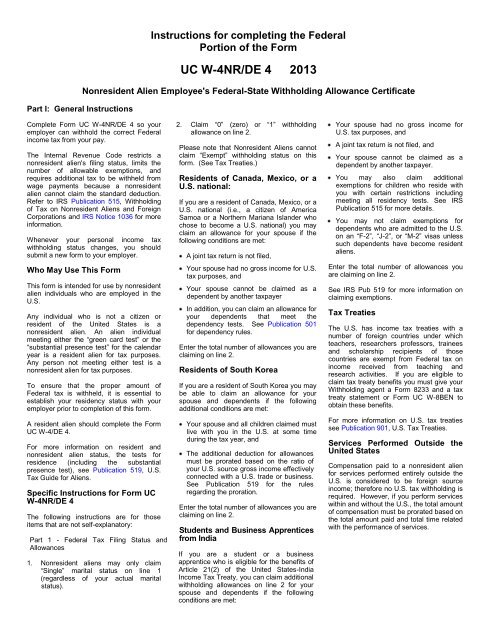

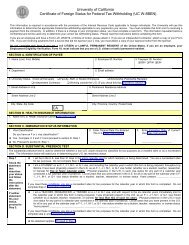
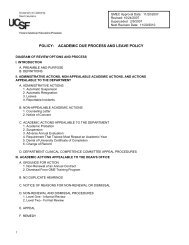
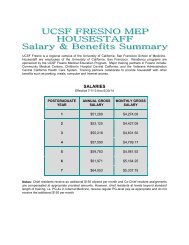
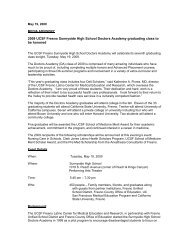
![Assistive Mobility Devices For Prevention Of Falls[1] - UCSF Fresno](https://img.yumpu.com/48127846/1/190x245/assistive-mobility-devices-for-prevention-of-falls1-ucsf-fresno.jpg?quality=85)
